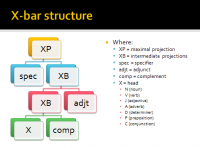X-bar theory
The X-bar theory was first proposed by Noam Chomsky (1970)[1]. It postulates that all human languages share certain structural similarities, including the same underlying syntactic structure, which is known as the "X-bar". The Default Grammar is based in a modified version of the X-bar approach, as indicated below.
Contents |
X-bar
The X-bar abstract configuration is depicted in the diagram below:
- X is the head, the nucleus or the source of the whole syntactic structure, which is actually derived (or projected) out of it. The letter X is used to signify an arbitrary lexical category (part of speech). When analyzing a specific utterance, specific categories are assigned. Thus, the X may become an N for noun, a V for verb, an J for adjective, or a P for preposition.
- comp (i.e., complement) is an internal argument, i.e., a word, phrase or clause which is necessary to the head to complete its meaning (e.g., objects of transitive verbs)
- adjt (i.e., adjunct) is a word, phrase or clause which modifies the head but which is not syntactically required by it (adjuncts are expected to be extranuclear, i.e., removing an adjunct would leave a grammatically well-formed sentence)
- spec (i.e., specifier) is an external argument, i.e., a word, phrase or clause which qualifies (determines) the head
- XB (X-bar) is the general name for any of the intermediate projections derived from X
- XP (X-bar-bar, X-double-bar, X-phrase) is the maximal projection of X.
Constituents
The head, the complement, the specifier and the adjunct are said to be the constituents of the syntactic representation and define the four general universal syntactic roles.
Heads
In the X-bar diagram depicted above, the letter X is used to signify an arbitrary category. Thus, the X may become an N for noun, a V for verb, and so on. In the Default Grammar, there are eight different types of heads:
- N = nouns and nominals: personal pronouns, demonstrative pronouns, nominalizations, etc
- V = verbs
- J = adjectives
- A = adverbs[2]
- P = prepositions
- D = determiners: articles, demonstrative determiners, possessive determiners, quantifiers
- I = auxiliary verbs
- C = conjunctions
The heads define the nature of the phrase structures, thus:
- N projects a Noun Phrase (NP)
- V projects a Verbal Phrase (VP)
- J projects an Adjective Phrase (JP)
- A projects an Adverbial Phrase (AP)
- P projects a Prepositional Phrase (PP)
- D projects a Determiner Phrase (DP)
- I projects an Inflectional Phrase (IP)
- C projects a Complementizer Phrase (CP)
Specifiers
Specifiers are used to narrow the meaning intended by the head. They include:
- articles: the (book), a (book), etc.
- possessive determiners: my (book), your (book), etc.
- demonstrative determiners: this (book), that (book), etc.
- quantifiers: no (answer), every (hour), etc.
- intensifiers (emphasizers, amplifiers, downtoners): very (expensive), quite (well), nearly (under), etc.
Complements
Complements are used to complete the meaning intended by the head. They may be:
- direct objects: (do) something, (give) something
- indirect objects: (laugh at) something, (give to) someone
- complement of deverbals (i.e., nouns deriving from verbs): (construction of) the city, (arrival of) Peter
- complement of adjectives: (loyal) to the queen, (interested) in Chemistry
- complement of adverbs: (contrarily) to popular belief, (independently) from her
- complement of prepositions: (under) the table, (after) today
- complement of conjunctions: (and) Peter, (I don't know if) he'll come
Adjuncts
Adjuncts are used to modify the meaning intended by the head:
- adjectives: beautiful (table)
- adverbs: (speak) slowly
- prepositional phrases: (table) of wood
Examples
| NP | VP | JP | PP |
|---|---|---|---|
NP
/ \
/ \
/ \
/ NB
/ / \
spec head comp
| | |
D N PP
| | |
the construction of Babel
|
VP
|
VB
/ \
/ \
/ \
VB \
/ \ \
head comp adjt
| | |
V N A
| | |
(he) bought something yesterday
|
JP
/ \
/ \
/ \
/ JB
/ / \
spec head comp
| | |
A J PP
| | |
(I'm) really interested in Chemistry
|
PP
|
PB
/ \
head N
| |
without notice
|
Phrases
Specifiers, complements and adjuncts are themselves complex
